The Native American tribes in the center of the vast North American continent were famous bison hunters in the 18th and 19th centuries, especially where the prairie ecosystems supported huge herds. Bison were keystone organisms in the prairies, and so too were the humans whose cultures depended on bison spiritually and for a large part of their subsistence, shelter, and tools. We associate these historic tribes with bison hunting on horseback, using bows and arrows, but horses only arrived with Europeans in the 16th century, and the bow-and-arrow reached the Plains sometime shortly after 2000 years ago. By this time the ancestors of today’s tribes had already been hunting bison for over 10,000 years. The weapon they relied on most was the atlatl, or spearthrower.
Atlatls are one of humans’ first complex mechanical tools, an arm-length stick with a handle on one end and a hook that articulates with a light spear (a dart in archaeological parlance), on the other. The motion in throwing with an atlatl is much the same as throwing with a ball: the strong muscles of the legs and torso start the movement, the arm and shoulder follow, and at the end of the throw, a flick of the wrist provides much of the velocity to the projectile. The atlatl in effect lengthens the lever of the wrist and hand and allows a light spear (think very large arrow or small, flexible spear) to be thrown with enough force to do a lot of damage. People all over the Americas used atlatls for thousands of years, so there is interesting variability through time and geography. Bows eventually superseded atlatls in most places because they are easier to use and more accurate. For years we have taught students with atlatls; an enjoyable target sport is a good way to introduce people to the study of prehistoric technology. While students can easily learn to craft their own atlatls and throw with them, they soon come to respect the skill and knowledge that was needed to make prehistoric tools effective. It is also easy to use atlatls to discuss the history of technology, principles of physics, and the design of scientific experiments. Part of what we do as archaeologists is reconstruct prehistoric tools from archaeological evidence and test them in laboratory and field experiments.
Archaeological finds demonstrate thousands of years of hunting success with atlatls, killing everything from Pleistocene mammoths, to bison on the Plains, to deer and smaller game in the Woodlands and, all too often, other humans. When prehistoric hunters set out to take large game, what could they expect in the way of killing efficiency, penetration, range, and durability of points and darts? What was the best equipment to take a particular animal? We moderns can never live prehistoric lives, but experiments can help us understand them better.
The kind of experiment you set up strongly affects the kind of things you learn. “Naturalistic” experiments are attempts to come closest to the conditions of prehistoric hunting. The most naturalistic atlatl experiments are performed by the many atlatlists who have successfully hunted deer, feral pigs, and other game in recent years. Modern hunts prove that atlatls are effective, but it is difficult to learn specific things from them. Each hunt and hunter is different, nobody uses the same equipment, and usually there is only one shot, so it is difficult to build up a body of experience to allow us to say whether heavy darts penetrate deeper or faster darts are better, whether obsidian points are durable enough, how close you need to be for an effective shot, and so on. Prehistoric hunters accumulated a lifetime of hit-and-miss experience, years of stories and teaching from elders, arguments with their peers, and fiddling with personal equipment. Some of that experience may exist among modern hunters, but it is hard for us to collect it and learn from it. For instance, modern hunters have killed hundreds of deer with stone-tipped arrows, but no one has recorded or collected information on size of point, material, poundage of bow, or range of shot that would allow us to make generalized statements about what works best under different conditions.
This is why “controlled” experiments (think traditional lab experiments) are useful. By reducing the number of variables, we can look closely at some of them. Some atlatl experiments are very controlled, using calibrated crossbows to get the same projectile velocities with identical points and shooting into synthetic materials such as ballistic gel to understand penetration in consistent materials. But such controlled experiments are much further from the realities of shooting prehistoric projectiles into a live animal. For example, ballistics gel works for bullets, but previous testing reveals that it produces erroneous results when testing slow projectiles like atlatl darts and arrows.
Experiments like ours are in between these ends of the experimental spectrum: we use a variety of reconstructed prehistoric equipment on carcasses. Shooting into a dead bison is not like a live bison hunt, but you can record and control lots of the relevant variables that mean success or failure with stone-tipped darts. It is also more ethically acceptable than killing an animal as an experiment, where you cannot guarantee a relatively quick and painless death. This may not have been of concern to prehistoric hunters, but it is today.
We use animals that are raised for meat (so far three bison, a couple of goats, and a hog), humanely killed by ranchers shortly before our experiment, and we salvage all meat and as much hide and sinew (for building future equipment) as possible. We usually butcher with stone tools, another set of experiments. The skeletons are cleaned to examine the damage that stone-pointed projectiles do to bones; this helps us understand wounds we see on animal (and human) bones from archaeological sites.
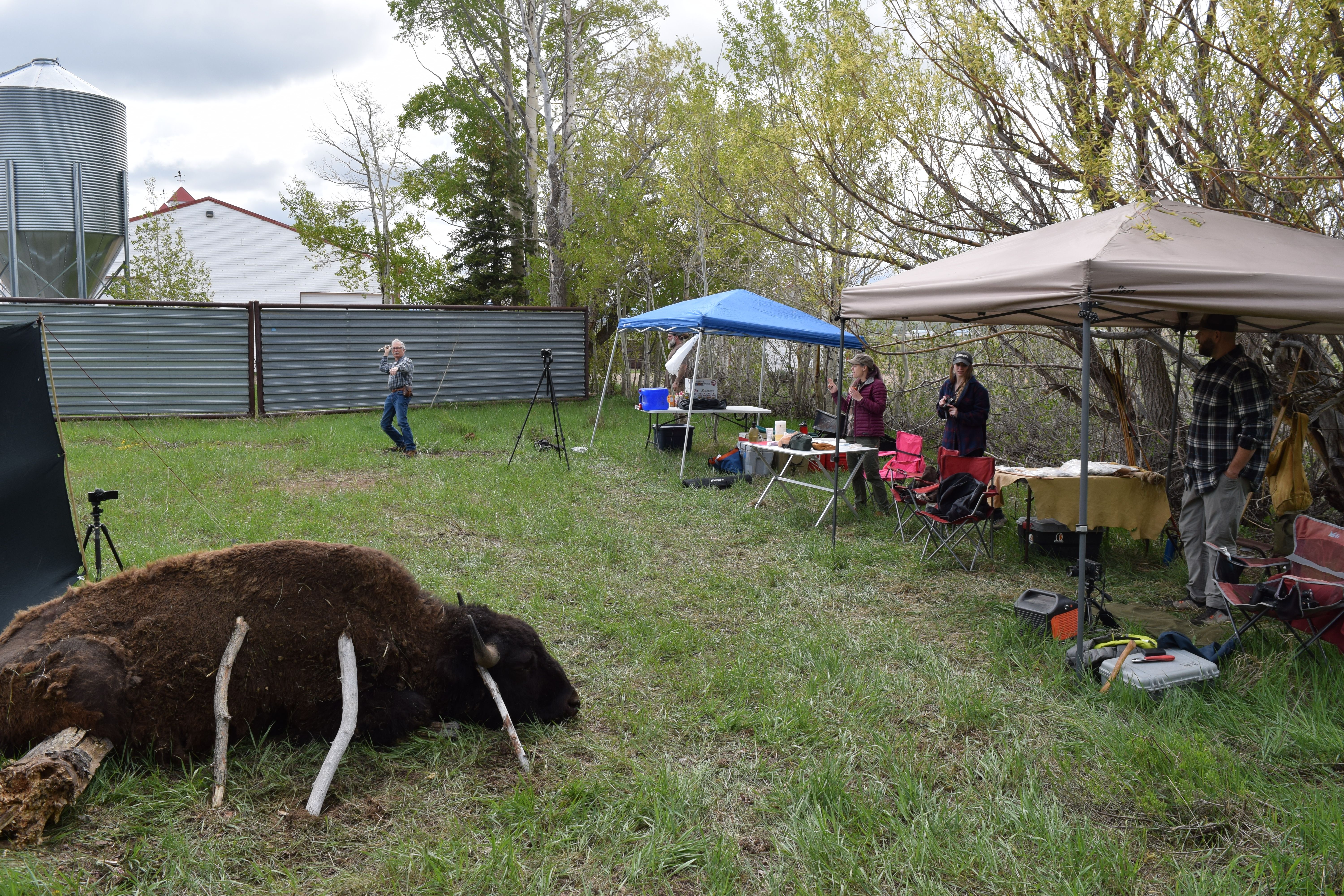
Experimental set-up, with bison and second camera in foreground.
Our series of experiments is intended to answer questions about the effectiveness of different kinds of stone points, dart weights and velocity, and the kinds of damage suffered both by stone points in hunting and the bones they impact. Our experiments are naturalistic experiments; using carcasses with variable anatomy, human atlatlists, and a variety of different stone points and other equipment, thus there are many variables to consider all at once. We compensate for some uncontrolled variables, such as the differing velocity of throws with different equipment and different people, by using a large number of shots and directly measuring variables like velocity and weight of darts. Modern technologies like high-speed cameras allow us to observe and quantify variables that were not easily apparent to prehistoric hunters. Statistical programs and our understanding of physics help us see complex relationships among many interacting variables.
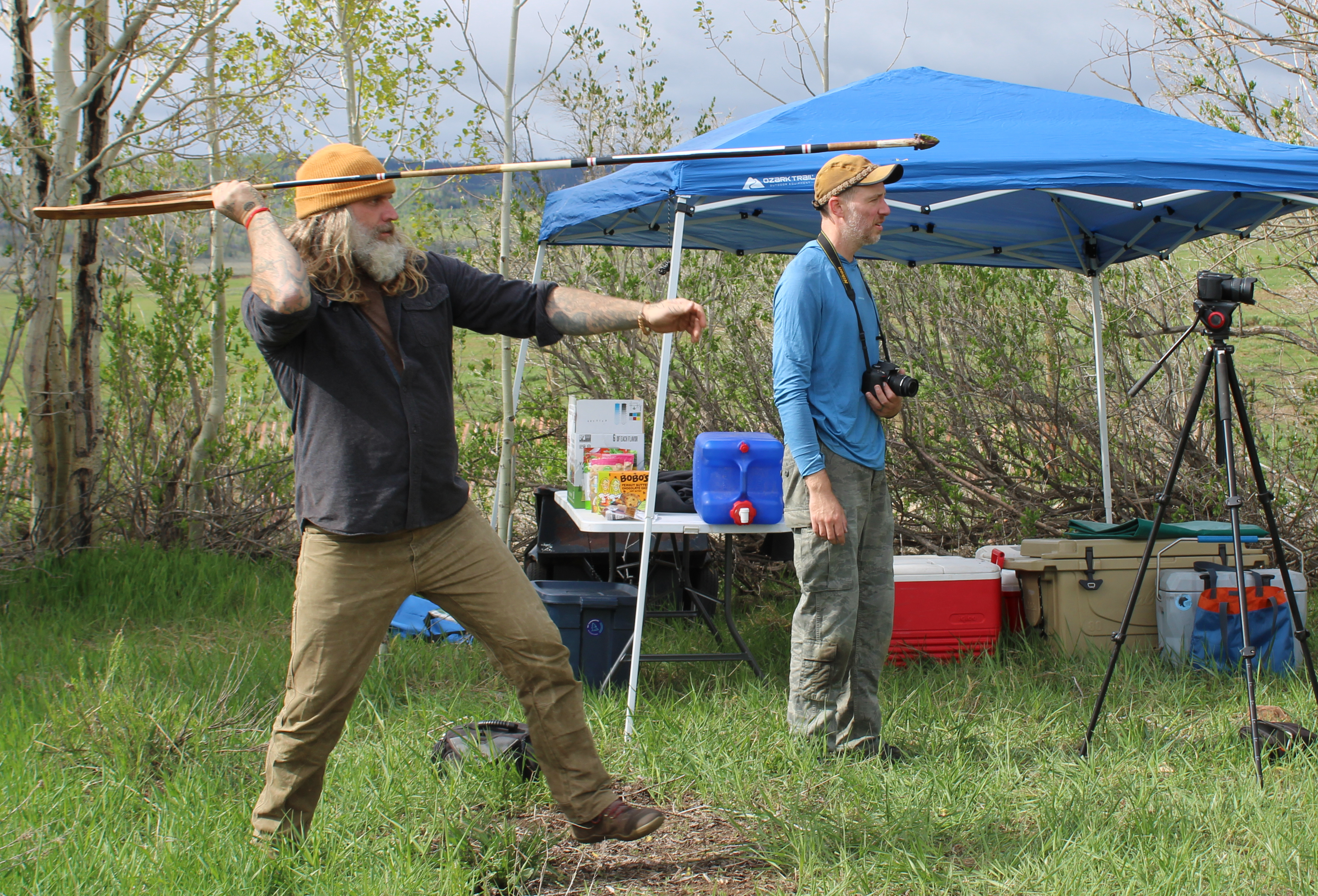
Donnie Dust throwing a heavy dart with first camera in position, with Devin Pettigrew recording.
We use two high-speed cameras to film impacts in slow motion. One is set near the thrower and aimed at the bison to record the flight and impact location of the darts. The darts are marked so that this camera can also be used to observe their movement and the resulting orientation of the stone point at impact. A second camera records the impact of the dart or arrow from near the bison and perpendicular to the flight path. Video from this camera is used to measure the velocity and deceleration of each shot on impact. Several of the team members throw, so we stay fresh, each using atlatls that they are comfortable with, but all similar in size. We throw from 12 meters away from the bison, which was a typical hunting distance with pre-firearm weapons and which allows good accuracy with atlatls.
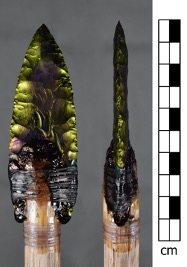
Hunters’ equipment: replica Clovis point hafted with sinew and resin in its foreshaft, dyed with methyl violet, and fitted to the mainshaft, ready for the experiment.
The image above shows the construction of a typical dart replicating some ancient examples. Each projectile point is individually hafted on a hardwood foreshaft. The foreshafts fit into a socket on one of several long mainshafts made of cane. The mainshaft has the feather fletchings, and a socket on the end to fit the hook on the atlatl. Our carefully crafted darts take several hours of labor each, plus more to put a stone point on its foreshaft. The stone points are the least of the work, probably averaging about an hour each to knap. Prehistoric hunters would have spent a lot of time on their equipment as well, because success depended on it. Each piece of each projectile is weighed, photographed, and measured before use, and points are dyed with methyl violet to make damage more visible.
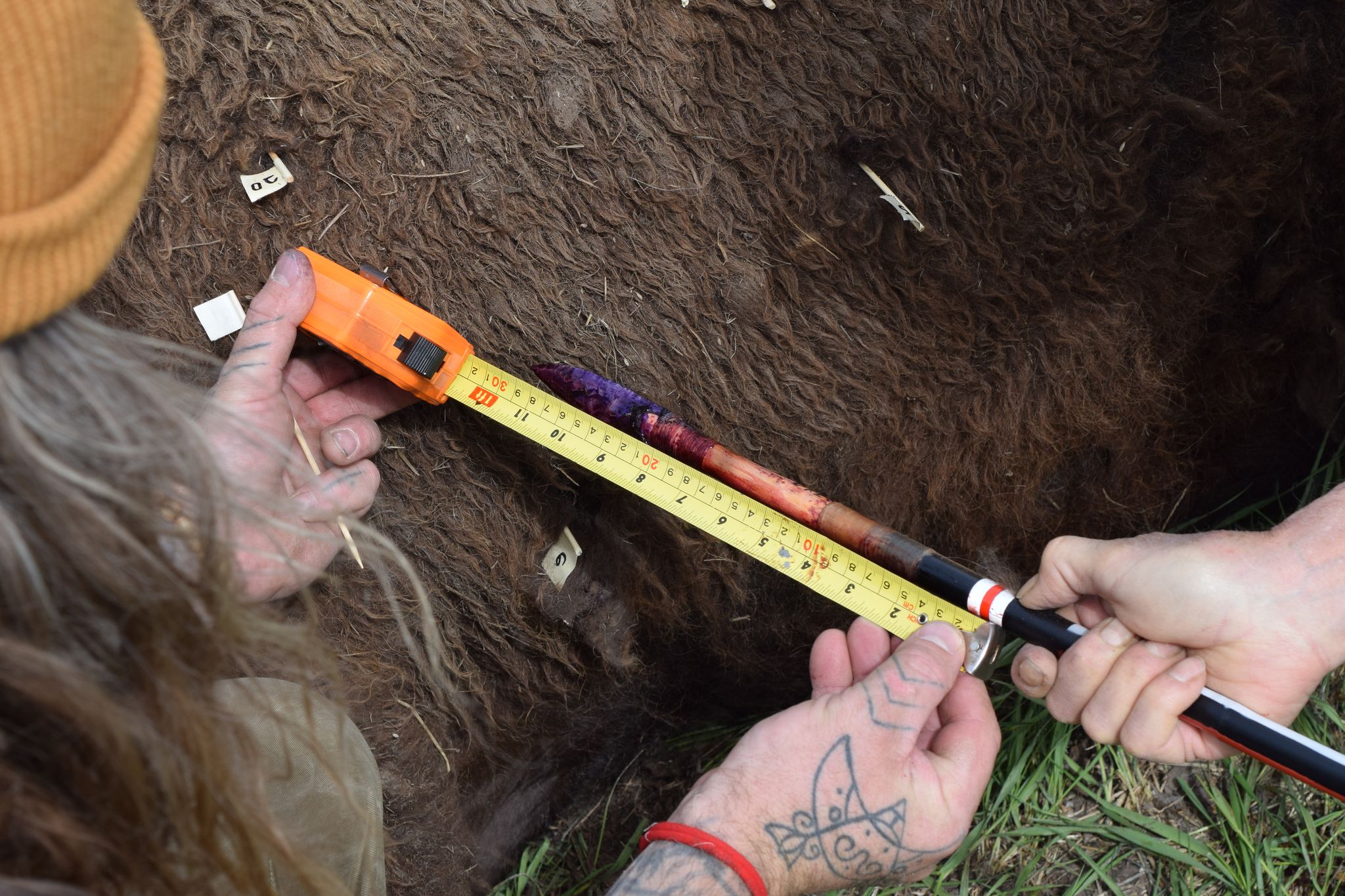
Penetration depth is measured after a successful shot.
After each impact the location of the hit and the results are recorded, and each wound is marked with a numbered flag on a wooden pin as the point is withdrawn. Penetration depth is measured, and fragments of damaged points are collected. Each point is photographed after each shot to document any damage. Our team of half-a-dozen people typically manages 60-70 shots with 50+ stone points on a bison. The shots, plus butchery and clean-up, take the team a full dawn-to-dusk day. This kind of experiment takes a lot of time. The fieldwork is preceded by months of preparation of the necessary points and darts and is followed by an even longer period of analysis.
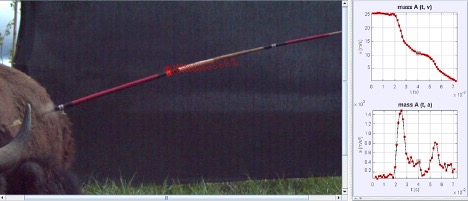
Tracker screen shot recording impact of a dart with Clovis point.
The previous image shows the kind of data produced by the cameras: a screen capture from the Tracker video analysis program showing a shot with a Clovis point which penetrated (on the left) towards the back of the thorax. For this shot, and many others like it, the most rapid drop in velocity (upper graph, y-axis) occurs as the point penetrates the skin. The x-axis tracks the distance of the penetration in meters, with zero indicating the moment of initial skin contact. The acceleration data (bottom graph) shows two high peaks in deceleration: The first begins as the skin stretches on impact and the point begins cutting through it. This peak reaches its climax when the haft area pushes through the skin, ca. 10 cm into the carcass. This was a particularly good shot that passed entirely through the bison. The second peak occurs deeper in the carcass, ca. 46 cm, and probably indicates the moment when the point hit the skin on the opposite side of the bison’s body. At this juncture, penetration ceased and the remaining velocity and acceleration values reflect vibration of the dart shaft. Although this dart struck with a whopping 106 Joules of kinetic energy, by the time it encountered the opposite wall of the torso it retained only 15 J. Most of its energy (ca. 60 J) was used to penetrate the hide. Sharper, thinner points that were more efficient at penetrating hide lost less energy and made lower energy darts more lethal, but also tended to be less durable when impacting bone.
So how do we interpret this data to make our experiments worthwhile?
It is no surprise that stone-tipped atlatl darts are capable of killing large game; archaeological evidence shows thousands of years of success hunting game from mammoths on down. We work a lot with atlatls from the American Southwest, from a culture archaeologists call “Basketmaker” (ca 2000 BC to 500 AD). Dry caves in the SW have preserved wooden equipment that usually perishes, so we have more complete ancient atlatls and darts from there than from anywhere else. These atlatls have a consistent basic form, and the surviving darts are also consistent, usually made of willow, and are relatively light. Nevertheless, Basketmaker style darts penetrated deeply when they did not hit bone. One sharp point made of agate mounted on a replica White Dog Cave willow dart weighing 90 grams and traveling 54 mph penetrated completely through a bison thoracic cavity. Heavier darts were even more effective, and we regularly got penetration depths of 30 cm or more, surely killing shots.
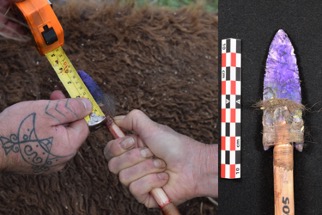
Clovis point penetration inhibited by dirty hair; the extreme tip was also dulled on impact.
This comes with the important exception of heavy bones. A much earlier American culture, known to archaeologists as “Clovis” (ca 11,500-11,000 BC) hunted the last of the Pleistocene animals; their distinctive large stone points are found among the bones of butchered mammoths. Needless to say, we have no mammoths to work with, nor even modern elephants, their closest living relatives. We have no Clovis atlatls to test because none have been found in the archaeological record, but the points, and the game they attacked, imply heavy darts. A strong thrower with an atlatl can accelerate a dart weighing 230 grams (around 8 ounces) to 60 mph, which is about as fast as anyone can throw with an atlatl. At such a velocity, heavy darts carry a great deal of kinetic energy and momentum, the two usual measures of the damage and penetration ability of a projectile. Our heavy darts mounted with Clovis points were highly effective. When they did not strike bone, they could pass through a bison’s body, but even these heavy darts had trouble penetrating when they struck ribs. The wooden foreshaft and its junction with the mainshaft were particularly vulnerable unless they were very carefully crafted. The condition of the animal is also important: one of our bison, a large male, had shaggy hair with a lot of dirt in it, which greatly inhibited penetration of some darts.
You would expect stone points to be fragile, but in fact many are surprisingly durable. Even those that glanced off a rib and took some damage often continued to penetrate. We had several points that made multiple trips to the bison before we had to retire them. On the other hand, those that ran directly into a rib often shattered, sometimes explosively, or the glue and sinew attaching the point to the foreshaft failed. The patterns of point damage are important to us because stone tools preserve better than most prehistoric artifacts, and the damage on them is often diagnostic of their use. We know this because our experiments replicate common patterns of damage on archaeological specimens as depicted in the next image.
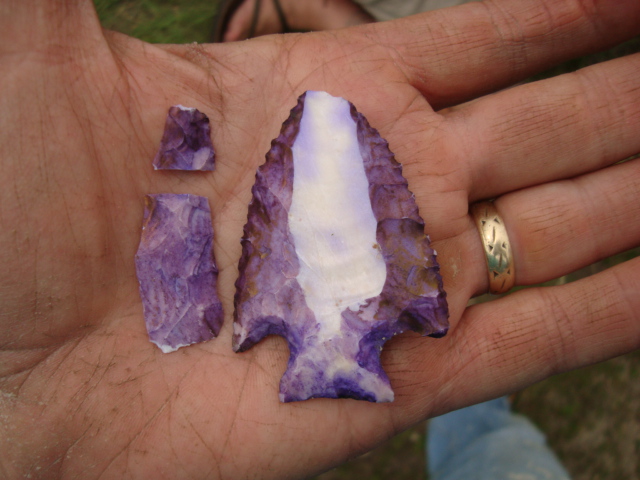
A common pattern of impact damage: a large flake removed from the tip of the point.
Projectile experiments also help us consider enduring questions about technological and social change. Why did prehistoric societies mostly shift quickly to the bow and abandon the atlatl when bows were introduced? Experiments show the possible advantages and disadvantages of different weapon systems. In a broadly generalized trend in weapon technology, moving from stones to spears to atlatls to bows to guns and beyond, technology increasingly replaced human strength and increased the distance between the user and the target, making a hunter or warrior more effective at greater distance and safer from dangerous prey or enemies. Throwing a javelin requires strength to accelerate a heavy projectile, and it has short range. Throwing a lighter dart with an atlatl allows greater distance with accuracy, and requires less muscle, so more people in a society are potential hunters or fighters. A bow and arrow has even greater range, but the light projectile needs to be faster to maintain penetrating power.
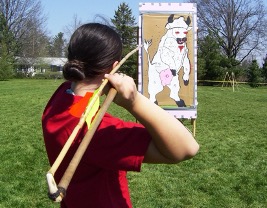
Grinnell College student Anu Kramer aims at our ‘Raging Cow’ target, a spoof on prehistoric Iowa.
These generalizing comparisons are complicated by a number of considerations. First, there is a lot of variability in any weapon system. Second, all weapon systems are designed around compromises—for example, increasing penetration by increasing projectile weight means you need more power to accelerate it. Third, and most importantly, the design variability and compromises reflect the conditions under which a weapon is used—the target and its behavior, the environment, available materials, and especially human skill, practice, and cultural needs. For example, let’s reconsider the replacement of atlatls by bows. You can become quite accurate with an atlatl at hunting distances of 15-20 meters and beyond, but it takes a lot of practice. We have good evidence from modern experimenters, including the small world of atlatl sport competition, in which we both participate. But a dart is thrown, and all throwing involves a lot of human error—consider the records of even the best baseball pitchers. An arrow on the other hand, is shot from a spring device, making it much easier to aim and shoot consistently, and far easier to learn to be accurate at hunting ranges.
However, many ethnographic and prehistoric bows were relatively weak, and their arrows are light and do not have the penetrating power of slower but heavier atlatl darts. Bows also tend to be more difficult to produce and more easily broken or damaged. These may be some of the reasons why atlatls survived in a few places along with bows. The word ‘atlatl’ is from the Nahuatl language of the Aztecs, who used bows, but preferred atlatls in combat, probably because they were better for penetrating the shields and padded cotton armor of their enemies. The Spanish conquistadors feared the Aztec atlatls, which were apparently effective against armor such as chain mail, though not (contrary to internet myth) against steel plate armor. Is it better to use a light, fast projectile, or a slower, heavier one with more penetration? That depends on the game you hunt, its size, speed, and toughness, and on the skill and accuracy you can develop or need. Then there are many other factors: are you hunting in open or wooded terrain, do you need to carry lots of ammunition (arrows are smaller and lighter), or be stealthy (there is less motion in a bow shot than in throwing)?
Prehistoric bison hunters on our prairies fed and clothed themselves using atlatls for thousands of years. It is not always clear which compromises affected the choice to switch to bow and arrow. We have experimented with bows as well as atlatls on our bison carcasses. Even bows that are light by modern hunting standards, and arrows with small stone points, penetrate well as long as they don’t hit bone. We suspect that the greater ease of learning to shoot accurately with a bow is probably a strong factor in their adoption. When another revolutionary technology, the horse, arrived on the Plains, other technological changes followed, as is usually the case. Horses allowed fast pursuit of bison and rapid retreat from angry wounded animals. Bison-hunting bows became short and powerful. The horse, the bow, and the bison became enduring symbols of the Plains tribes.
A broader lesson we take from our experiences is that all technology can be studied with the same sort of experimental approach. In fact, we do it all the time, from the level of personal experience with the objects around us, to elaborate research and design projects for high-tech mass-market goods. Every human artifact exists in a complex web of relationships with other technology and the material and intangible needs of the humans who use it. Detailed investigation of the functioning and capabilities of any technology illuminate deeper questions of technological change and human adaptation to their social and physical environment.
Acknowledgements
This project would not have been possible without a team of effective experimenters including Patrick Hashman, Donny Dust, Carlton Shield-Chief Gover, Lana Ruck, Autumn Cool, Leah-Marie Hersh, Justin Garnett, Bobby Marshall, and Marissa Crise. The many projectile points were made by the authors and several other knappers; Pettigrew built most of the darts. Animals and space to work have been provided by Troy Westre (Bitterroot Bison), Joe Beauprez (Eagle’s Wing Ranch), Barney Bahrenfuse (B&B Farms), and Matt Clyker. We have received support from our institutions, Grinnell College (JW), University of Colorado, Boulder and Sul Ross Texas State University (DP), and private individuals. Douglas Bamforth and Marvin Kay guided Pettigrew in many aspects of his research.


